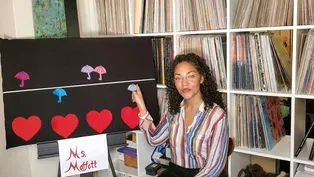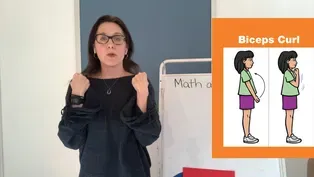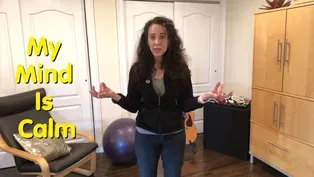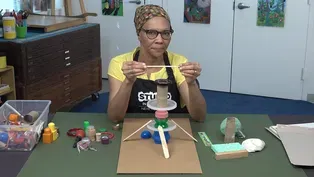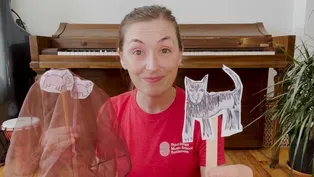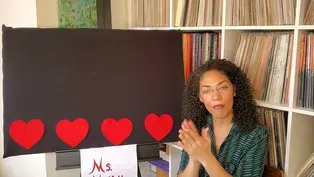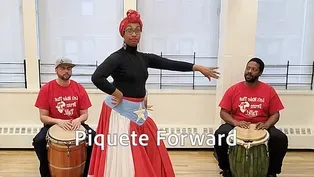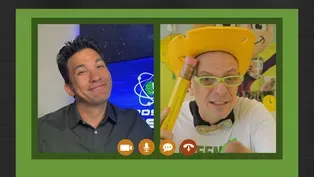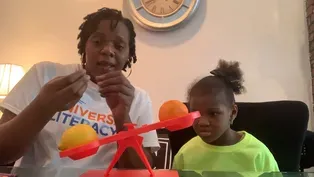
I is for Insect!
1/28/2021 | 56m 9sVideo has Closed Captions
Learn about bees and pollination, acting for singers, and feeling sizes; read MAMA ZOOMS.
Learn about bees and pollination, acting for singers, and feeling sizes; read MAMA ZOOMS; blend sounds and practice short i, g, and k. LET’S LEARN helps children ages 3-8 with at-home learning. One-hour programs feature instruction by educators and virtual field trips.
Problems with Closed Captions? Closed Captioning Feedback
Problems with Closed Captions? Closed Captioning Feedback
Let's Learn is a local public television program presented by THIRTEEN PBS

I is for Insect!
1/28/2021 | 56m 9sVideo has Closed Captions
Learn about bees and pollination, acting for singers, and feeling sizes; read MAMA ZOOMS; blend sounds and practice short i, g, and k. LET’S LEARN helps children ages 3-8 with at-home learning. One-hour programs feature instruction by educators and virtual field trips.
Problems with Closed Captions? Closed Captioning Feedback
How to Watch Let's Learn
Let's Learn is available to stream on pbs.org and the free PBS App, available on iPhone, Apple TV, Android TV, Android smartphones, Amazon Fire TV, Amazon Fire Tablet, Roku, Samsung Smart TV, and Vizio.
Providing Support for PBS.org
Learn Moreabout PBS online sponsorshipMore from This Collection
Video has Closed Captions
Read SCHOOL BUS and draw one, learn about prefixes and pitch, build sculptures. (57m 48s)
Running and Counting Both End in “ing”!
Video has Closed Captions
Move to improve, find the missing number, learn songs from Ghana, read ABUELITA’S SECRET. (58m 17s)
What Sound Does “aw” Make in Draw?
Video has Closed Captions
Read a story, discover "au" and "aw," learn about density, count, and move with music. (56m 58s)
Can You Find the Short “u” in Subtract?
Video has Closed Captions
Help Super Grover 2.0 solve a prickly problem, read ALL THE WAYS TO BE SMART. (56m 19s)
What Sound Does “gl” Make in Glove?
Video has Closed Captions
Play the glockenspiel, help Super Grover 2.0 make a cart move, read TWO WOOL GLOVES. (58m 9s)
Incredible Starts with Short “i”!
Video has Closed Captions
Solve problems with Super Grover 2.0, catch a rainbow, hear a piano sound like a cuckoo. (56m 9s)
What’s the Sound of “oo” in Book?
Video has Closed Captions
Explore animals’ form and function, sing about the 3 little pigs, read THE LITTLE BOX. (58m 15s)
We’re Reducing, Reusing and Recycling!
Video has Closed Captions
Learn all about rhythm and the number 9, read A BAG IN THE WIND. (56m 17s)
Video has Closed Captions
Learn to dance bomba and grow food in a city, read WOLF CUB’S SONG. (55m 20s)
How Many Syllables are in Invent?
Video has Closed Captions
Invent your own instrument, make 10 to add numbers to 20, read ONE GOLDEN RULE AT SCHOOL. (57m 36s)
Video has Closed Captions
Learn about the science behind mind reading, count shells, read MY BIG FAMILY. (57m 27s)
Which is Heavier: One Apple or Two Apples?
Video has Closed Captions
Defy gravity, learn secret code words for fast and slow in music, read WHOOO KNEW? (58m 5s)
Providing Support for PBS.org
Learn Moreabout PBS online sponsorship[upbeat music] - [Narrator] Ready to learn?
- Hi.
- Hi.
- [Narrator] It's time to share a story, read and write.
- Let's read it back.
- [Narrator] Discover science, sing.
♪ Somewhere ♪ - [Narrator] Play, and so much more.
- Cupcake.
- Very good.
- [Narrator] Stay tuned for lessons and activities.
- We're gonna start making some words.
Isn't that fun?
[upbeat music] - [Narrator] Funding for this program was provided by The JPB Foundation.
[upbeat music] - Hello friends, welcome back.
I'm so excited to be here with you again, reading another wonderful story together.
This one is called "Mama Zooms," by Jane Cowen-Fletcher.
Whenever I pick up a story to read, I like to make a prediction.
That means I want to guess what the story might be about before I actually start to read it.
And how can I do that?
Well, I can think about the title.
So the words and the title might give me a clue.
I can also look at the illustrations.
Usually the illustrations and the title together give us a pretty good clue as to what the story might be about.
And for this story, I'm also going look at the back.
So the back cover, there is a very detailed illustration in the back.
And I think all of these things combined, I can make a pretty good guess as to what the story might be about.
But predictions are just a guess, right?
So we might be right and we might not be so right.
And either way that's okay because we'll read the story together and we'll see if our predictions were right, and if not, that's totally okay too.
So why don't we take a minute or just a few seconds with your trusted adults, think about the title, "Mama Zooms."
Look at the illustration on the front cover as well as the back cover, and go ahead and share your prediction with your trusted adults.
When you're finished sharing yours, ask your trusted adult to share their prediction, and we'll come back together and read the story.
[upbeat music] All right, friends.
Did you have a minute to share your prediction?
Great, so when I looked at the title, I read the title "Mama Zooms," and looked at the illustrations on the front cover and the back cover.
I started to wonder "Mama Zooms."
When I think about the word zooms, somehow it just makes me think of things that are going really fast.
That I look at the illustration on the front cover, and I see that both, the mom and the boy, have their arms out.
So I wonder if they're flying.
Looks like maybe the sky in the background, I'm not so sure.
And then I see their hair, it looks like the wind is blowing in their hair.
So are they flying up in the sky with the wind blowing, going really fast because the word zooms?
I don't know.
And then I looked at the back and I see some wheels here.
I wonder if it's a wagon, maybe it's a bicycle.
And then I see some different toys here I see an airplane in the little boy's hands, I see a boat, a train, a car, there is a horse and a carriage here.
Wait a minute, are those all different modes of transportation?
Some that go in the air, some that travel on land, some that go in water.
Wait a minute, is this a book about different transportations, maybe?
Mm-hmm, well, we're going to read and see what this book is about.
And before we get started, I want you to think about, as we read the story, I want you to think about all the different places this little boy goes with his mom.
When we're finished reading this story, we're going to do an activity together.
"Mama Zooms."
"Mama's got a zooming machine and she zooms me everywhere."
A zooming machine?
I wonder what that is.
Have you ever heard of a zooming machine?
[paper flapping] "Every morning daddy puts me in mama's lap and we're off."
I wonder where they're going in their zooming machine.
Do you know?
[paper flapping] "Mama zooms me across the lawn and she's my race horse.
Mama's zooms me through a puddle and she's my ship at sea."
Huh, these are different modes of transportation.
There is a race horse and then a ship.
[paper flapping] "Mama zooms me down the smooth sidewalk, and she's my race car.
Mama zooms me fast down ramps, we love ramps."
What is mama sitting on?
She's sitting on a wheelchair.
Is that different mode of transportation?
It sure is.
Some people have different muscles or their muscles work differently.
And this mama uses a wheelchair to move around.
[paper flapping] "Mama zooms me across a bridge and she's my airplane."
They sure are going to a lot of different places on their zooming machine.
"Mama zooms me through a dark hall and she's my train in a tunnel.
Mama zooms me over a bumpy road, and she's my buckboard wagon.
Mama zooms me along the ocean boardwalk, and she's my wave.
Mama has very strong arms from all of our zooming."
They sure did go to a lot of different places on their zooming machine.
"Daddy and I push her up only the very steepest hills.
When we get to the top, daddy says, 'See you back on earth."
See you back on earth?
Where are they going to go to next?
What do you think?
Maybe, let's see.
"And mama zooms me to the stars, and she's my space ship.
Mama zooms me right up until bedtime, then mama is just my mama, and that's how I like her best."
And that's the end.
So now we're going to do an activity together.
I want you to use your imagination.
What does it mean to use your imagination?
That means to use your brain.
Let it take you to a place that you had never gone to before.
Let it allow you to be someone that you've always wanted to be, or something that you've always wanted to do.
For example, maybe you have always wanted to fly to the moon.
Guess what?
We can fly to the moon.
Maybe, oh, I just thought of something too.
Maybe you've always wanted to be a bird.
I would love to be a bird and be able to fly.
I can certainly pretend.
So we're going to use our imagination and pretend to go somewhere, be someone or do something just like mama and the little boy were pretending to go to all sorts of different places on the zooming machine.
Were are they really going to all those different places on mama's wheelchair or were they using their imagination?
Yeah, they were using their imagination, right?
They pretended to fly over a branch, they pretended to go through a dark train tunnel.
For this next activity, you're going to grab a piece of paper and some drawing utensils such as colored pencils, crayons, markers, paints, or a pencil, whatever you like.
And as you use your imagination to think of a place you'd like to go or someone you like to be, or something that you like to do, you're going to draw a picture of that.
Remember to use your imagination.
Be as creative as you like.
The other option is, if you don't want to draw, you can act it out.
So with your trusted adults, you can take turns.
I am going to show you what I'm going to do.
So instead of drawing a picture, I decided that I'm going to act it out.
And I love music and I sure do enjoy dancing.
I've always wanted to be in a music band, but guess what?
Nobody ever wanted to let me play the drums and that was the instrument I wanted to play.
So no problem, I am going to use my imagination.
I went in the kitchen cabinet and I got myself a bowl and a spoon and guess what?
I'm going to make my own drums.
And I'm going to bang, bang, bang, bang and pretend like I am a rock star.
I am a famous musician in a very, very, very famous band and there are thousands of people here watching us perform tonight.
And I am the lead drummer of this band and I am so good at playing the drums, doesn't that sounds so good?
Do you like it?
So I just use my imagination.
I can't really play the drums, but I can pretend.
It's really fun to sometimes just pretend to be somewhere, maybe just on a beach where it's sunny and warm and I'm building a sand castle or like I was here playing the drums or maybe I can be a bird and I can just fly.
Oh, maybe I can be a bird and fly to that beach.
Okay, enough about things that I'm imagining.
Now, it's your turn.
So you go ahead and either draw the picture and share it with your trusted adult or you can act it out.
Remember, you can also ask your trusted adult to do the activity with you.
It's super fun.
I hope you enjoyed "Mama Zooms" by Jane Cowen-Fletcher.
See you soon friends.
- Hi, movers and shakers, this is Violet, and I'm here again with my friend, Jeremy, and he's gonna help us sing a song.
First, I wanna shout out one of our friends, Dani, who helps us read stories sometimes.
She requested this song because she wanted us to spread some joy and positivity during these challenging times.
- Thank you Violet once again for having me come on and share a song with you about feeling good.
I have a question for you.
What do you do when you're having a bad day?
- I like to laugh or play games with my friends.
I even like to sing and dance with them too.
- Nice, that's so funny because I love those same things too.
I love hanging out and sitting with my friends.
It always makes me so happy.
In fact, I have a song that I think you would love and I think most of you would know.
If you do, feel free to sing along.
Move your hands, dance in your seat or jump up and down and dance and sing along with us.
It's called, "Can't Stop the Feeling."
♪ I got this feeling, inside my bones ♪ ♪ It goes electric wavey when I turn it on ♪ ♪ And if you want it inside your soul ♪ ♪ Just open up your heart let music take control ♪ ♪ I got that sunshine in my pocket ♪ ♪ Got that good song in my feet ♪ ♪ I feel that hot blood in my body when it drops, ooh ♪ ♪ I can't take my eyes up off it moving so phenomenally ♪ ♪ Room on lock the way we rock it, so don't stop ♪ ♪ And under the lights when everything goes ♪ ♪ Nowhere to hide when I'm getting you close ♪ ♪ When we move well, you already know ♪ ♪ So just imagine, just imagine, just imagine ♪ ♪ Nothing I can see but you when you dance, dance, dance ♪ ♪ Feeling good creeping up on you ♪ ♪ So just dance, dance, dance ♪ ♪ come on ♪ ♪ All those things that shouldn't do ♪ ♪ But you dance, dance, dance ♪ ♪ And ain't nobody leaving soon so keep dancing ♪ ♪ Dance, dance ♪ ♪ I can't stop the feeling ♪ ♪ So just dance, dance, dance ♪ ♪ I can't stop the feeling ♪ ♪ So just dance, dance, dance ♪ ♪ Come on ♪ - Thanks everyone, thanks Jeremy.
Hope you all had fun dancing.
[upbeat music] - Well, hello learners, we're back again today.
My name is Renata and we're gonna have ball with sounds and words.
First, we're gonna be blending chunks of sound together to make words.
Then we're gonna blend sound by sound and at the very end, we'll read some words and write a little bit together.
Let's get started.
The first little game we're gonna play, I'm gonna say two parts of a word, the beginning sound and the last sound.
And then we're going blend it together to say the word.
But here's the fun part.
I have three pictures, a duck, keys and a yak.
So you have to pay attention to see if we have blended one of these words.
I'll put them over here.
Great, so let's try one together to practice.
Jog, put those sounds together, jog, it's jog.
You try, duck, put it together, duck.
Did we say one of the words?
We did, we said duck.
Here's another lake, lake.
Together, lake.
Did we find a word?
No, not yet.
Here we go, one more.
keys, again, keys, together, keys.
Yes, you're right, we just said keys.
Here comes another one.
Rod, rod, together, rod.
No, we didn't say one.
Let's try another one.
What about dig?
dig, together, dig.
No, I don't see a picture of anything digging.
Let's try one more.
yak, yak, together, yak.
And yes we do, we have a big yak on the bottom.
Nice work.
[soft music] Okay, we're gonna play another game where you help me fill in a word in a sentence.
This time we're gonna make each sound in the word instead of chunks.
So listen to this first one I'll do.
The bus is big.
Do that with me, big.
Blend it, big.
The word is big and my sentence was, the bus is big.
Are you ready to try one?
Here we go, listen closely.
I lost my hat, do it again, hat.
Blend it, yes, hat.
The word is hat, I lost my hat.
All right, here's another.
What about I will sleep on the cart, cart.
Yes, you got it, cart.
I will sleep on the cart.
Last one, did you break a bone?
bone, yes, bone.
You have it, did you break a bone?
Nice work, you blended words sound by sound, excellent job.
[upbeat music] Okay, learners.
Now we're gonna listen for short and long vowel sounds.
Up until now, you've been learning about the short vowel sound for A, which is A, and the short vowel sound for I which is I.
The short vowel sound A could be inside a word like hat or cat.
And the short vowel sound can be in the middle of a word like dig or big.
You can hear it, I.
Now, these vowels also have another sound.
They have a long sound.
The long sound for A is A, and the long sound for I is I.
Let's see, for A, what about cake?
Do you hear that long vowel in the middle?
Or make.
And the long vowel sound for I?
What about hike or bike?
All right, so in this next little game we play together, you're gonna be listening for short and long vowel sounds and then you're gonna make them.
Listen to this word, kite.
Make the vowel sound you heard in the middle.
Yes, I, it's a long I.
Here comes another, back.
Yes, A, it was a short A sound.
How about gave?
Yes, A, you heard a long A.
What about big?
Yes, I, short I.
And how about kick?
Yep, short I again, I.
How about like?
Yes, I, long I in the middle there.
And how about wag?
Yes, A, wag has A, short A in the middle.
Okay friends, now we're gonna play a short game where you tell me which word has the short vowel A or the short vowel I in the middle.
Listen to these two words.
Bite, bit, which one has the short vowel?
Bite, bit.
Yes, bit has short I, I.
Here's another for you, mate, mat.
Say those words, mate, mat.
Where is the short vowel?
Yes, mat.
Here are two more words, fin, fine.
Say them again, fin, fine.
Yes, short I in the middle of fin.
How about these two?
Pan, pain, pan, pain.
Yes, pan has the short vowel A.
What about kite, kit?
Yes, kit has the short I in the middle.
Nice work learners.
[upbeat music] Okay, learners, we're getting to the end of our lesson and the funnest part.
We're gonna be reading words sound by sound.
You're gonna see some continents like G and K and a few others and you'll see the vowels we've been working with A and I in the middle of the words.
Help me read this word sound by sound.
Here we go, K-I, ki, K-I-T, kit.
The word is kit.
Let's practice with another.
Here we go.
G-A, ga, G-A-P, gap.
That word is gap.
One more practice before we read a few lines together.
All right, S-A, sa, S-A-G, sag.
Nice work learners.
Now, let's read a few lines together.
Follow my finger and let's read these words, sound by sound.
G-A-S, gas.
S-A-G, sag.
G-A-B, gab.
B-A-G, bag.
B-I-G, big.
Wow!
You just read gas, that gas for car.
Sag, like when your clothes are too big.
Gab, like talking and bag and big.
Let's go to the next line.
F-I-G, fig.
K-I-T, Kit.
K-I-D, kid.
D-I-D, did.
D-A-D, dad.
You just read, fig, it's a little fruit, kit, kid, did and dad.
Awesome work learners.
[upbeat music] Okay learners, we're gonna have some fun with short I.
What's that sound again?
Yes, I as in lid, fin and wig.
All of these words have short I in the middle, I.
Help me write the first word by making each sound with me.
Say lid.
Good, stretch it out, lid.
Excellent, make the first sound, L. Which should I write?
Thank you, L. I, what's next?
Yes, I.
Last sound, D, yes, D. Next word say fin.
Stretch it out with me, fin.
Make the first sound, F. Thanks for that.
Next sound, I, thank you.
Last sound, N, look at you.
Last word, say wig.
Good, stretch it out, wig.
Make the first sound, W, Yes, thank you.
Next sound, I, exactly.
Last sound, G, excellent.
Do you think we can write words that rhyme with these words?
I think we can.
Lid, do you think we can write hid?
Yes, what should we change?
If I wanna write H, H, hid?
You'll exactly write, H. And it rhymes so the rest of the word is gonna be the same.
Thank you, next word, fin.
I think we can rhyme with Fin, what about bin?
What should I change?
B, thank you.
I should write a letter B, and the rest of the word.
Last one, wig, I think we can rhyme with wig.
What about pig?
What should I change?
Yes, P, thank you for that.
And the rest of the word, ig.
Thanks for helping me rhyme.
Lid, hid, fin, bin, wig, pig.
Awesome work learners.
[upbeat music] Wow, learners we've done so much today.
You should be so proud of yourselves.
You helped me blend chunks of sounds to make words, you helped me blend sound by sound to make words.
We focused in on short and long vowel I, short and long vowel A.
You helped me read words sound by sound and blend them, and you also helped me with some fun worksheets, awesome job.
Please join us tomorrow so we can keep building on what we've been learning together.
Until next time, have a wonderful day.
Bye.
[upbeat music] - I check the labels on my kids' lunchboxes and toys.
You wanna know why?
- [Woman] The dangers of lead might feel like old news, but it's still a very real threat.
Lead is a dangerous metal that can cause serious learning and behavior problems in children and problems during pregnancy.
People with lead poisoning usually don't look or feel sick.
Lead can be found in old paint and in some products from other countries.
Here are a few things to look out for to protect yourself and your little ones from lead.
Lead paint was banned in New York City, but some buildings may still have lead in the older layers of paint.
If you notice peeling paint in your home, talk to your landlord immediately.
If your landlord doesn't act quickly, report the peeling paint to 311.
Health remedies, food, spices, pottery, cosmetics, toys and jewelry from certain countries may contain lead use with caution.
If the paint on a toy cracks, throw it out.
It's not worth risking exposing your child to lead.
Safe lunchboxes are labeled lead free.
Be sure to check for this label before you buy your little one a lunchbox.
Remind your doctor to test your one or two year old for lead poisoning.
Lead your family away from lead.
[upbeat music] [whooshing] [birds chirping] - Oh, hi, kids.
You caught me eating my snack.
What do you like to eat?
I bet it's good.
Well, I like to eat honey on toast.
I also like to eat apples and bananas.
I have a little secret about all three of these foods.
Do you wanna know?
Well, honey bees help make all three of these foods.
But how do honey bees help us?
Well, for one out of every three bites, we have honey bees to be thankful too.
Just like we say thank you to our family who makes food for us, we can say thank you to honey bees.
So that's one bite.
[upbeat music] Two bites.
[upbeat music] And three bites.
[upbeat music] Thank you, honey bee.
[upbeat music] So if we go back to our question, so let me get that, how do honey bees help us?
That's what we're gonna investigate today.
So I'm gonna put my scientists glasses on, I'm gonna grab my notebook and my pencil and we're gonna go find that out.
Why don't you come along with me?
Hi little scientists, thanks for joining me on our investigation on, how do honey bees help us?
Right behind me, bunch of flowers.
You know what?
I think I hear them buzzing behind me.
Let's have a look.
[humming] Okay little scientists, what do you observe?
I observe one bee.
I also observe that there are flowers and the flowers are white.
[humming] Wow, that's so cool.
Well, what are they actually doing?
Well, they go to work every single day, just like your teachers and your principals.
What these bees do is they hop from one flower to another flower.
And when they go from one flower to another flower, they collect nectar.
Nectar, can everybody say nectar with me, nectar.
Now, can you say it on your own?
Great, well, what they do is when they collect the nectar, they bring it back home for them to eat.
And so some of that nectar turns into the honey that we eat.
Can you think of some foods that have honey in it?
Tell you what, why don't you try asking someone at home to see what foods are made up of honey?
I bet you they can come up with a couple of things.
Here are some things that I can think of.
[upbeat music] So that's just one job of a honey bee.
But honey bees have an even more important job.
Do you remember at the beginning of the show when we talked about how we have to thank bees?
That out of one, out of every three bites, you should say thank you.
Well, that's because they collect something called pollen.
Pollen, now can you say it with me, pollen.
Now you say it on your own.
Great, and so when honey bees collect the nectar, they also pick up some pollen.
And that pollen sticks to their legs and to other parts of their body.
And when they fly from one flower to the next flower with that pollen sticks with that new flower.
This is called pollination.
Can you say it with me?
Pollination, now it's your turn.
Wow, that's great.
And allows us to get all the different types of fruits and vegetables that we eat.
And so the next time we take one, two, three bites, we can say thank you to our honey bee.
Let's take a look at a honeybee's home, beehives.
[upbeat music] Honeycombs.
[upbeat music] What do you observe, little scientists?
Well, I observe bees going into their hives.
[upbeat music] Who takes care of these honeybees?
- Let's go inside and take a look around in there.
- [Theresa] This is Beekeeper John.
[upbeat music] - Okay, we're inside now.
This is a little workshop.
At two years old, grandsons, all started at two years old, poured the honey into the jar and put in the label on.
At two years old, they wanted to all, all three of them did it at two.
So they helped me a lot with that.
They don't help too much with the bees, but they will come and look.
- [Theresa] When did you become a beekeeper?
- It was 1968.
We were working in the garden, getting this garden ready in the spring time, and I told my dad, I said, "I'm gonna take over the bees."
He said, "good."
So in 1968, I started with the bees and I've been working with them ever since.
- [Theresa] How many beehives do you have?
- Currently, I keep about 15 hives, sometimes I do 20 hives but it gets to be a lot of work.
Some people have hundreds of hives, I don't know how they do it.
- [Theresa] Can you tell us about the nectar?
- Here's some lilacs we pick.
Certain plants are good for making honey and some are not.
Some don't have much nectar and so they bring in nectar and pollen from the flowers.
And when the bee goes out, in a bees lifetime, which in the summertime could only be weeks long, they only bring in one twelveth of a teaspoon of honey.
A little teaspoon like they bring in just a little bit on the end here on a teaspoon and well, it's not on here, but you can imagine in their lifetime, that's six weeks 'cause they work themselves so hard, they get burned out.
To make one pound of honey, like this dark honey in a bottle it takes two million, they get to visit two million flowers to fill that jar.
So the numbers, when you talk about bees, how hard they work hard is amazing.
- [Theresa] What do you wear?
- When we bring our honey in, now here's the bee suit.
Everybody likes to wear a bee suit, my grandsons wear.
So we use that on a day like today when the sun's not hot.
- Wow, what an adventure.
I had so much fun learning with you.
Can we look at the question, how do honey bees help us?
And we learned that honey bees pick up nectar and they also pick up pollen.
And when they fly from one flower to the next, some of that pollen gets dropped off and this is called pollination.
And pollination is how we have different types of fruits and vegetables to eat.
So the next time you take a bite out of that apple, remember to thank our honey bees.
Well, that's it for today.
I had so much fun and I hope to see you sometime soon.
Bye little scientists.
[birds chirping] [upbeat music] [speaks in foreign language] [upbeat music] ♪ Somewhere over the rainbow ♪ [upbeat music] - Hi, friends.
I'm Janet, and I'm a teaching artist at the New Victory Theater.
I'm an artist who sings, I'm a songwriter, I'm an actress.
And we're here in my apartment in Manhattan.
We're gonna focus on acting for singers.
As singers, sometimes we're focused on sounding beautiful.
But if we truly wanna have the heart of our audience, then we also need to focus on our ability to communicate using our bodies, our faces, our gestures and our overall energy and that's where the skill of acting for singers becomes extremely useful.
So let's take a look at a song, "Somewhere Over the Rainbow."
It sounds a little something like this.
♪ Somewhere over the rainbow ♪ ♪ Way up high there's a land ♪ ♪ That I heard of once in a lullaby ♪ So let's imagine that I am an actress and I have been asked to sing this song with the feeling of confidence.
I would stand with my feet, hip distance apart, my shoulders would be up, back and down, my eyes would be wide and optimistic and my performance might look a little something like this.
♪ Somewhere over the rainbow ♪ ♪ Way up high there's a land ♪ ♪ That I heard of once in a lullaby ♪ How did that look?
All right, now you try.
Next, let's imagine that I'm a singer and I have been asked to act out the song with the feeling of anger.
I might stand with my knees slightly bent, my shoulders slumped, my eyebrows would be bending forward, my lip would be unturned, turned upside down.
My teeth might be tight and my performance would look a little something like this.
♪ Somewhere over the rainbow ♪ ♪ Way up high there's a land ♪ ♪ That I heard of once in a lullaby ♪ How does this look?
All right, now you try.
Next, let's imagine that I am an actress and I have been asked to sing the song feeling of sadness.
All right, so I might really slump forward.
My hips would come forward, my shoulders would drop all the way down.
My chin would drop all the way down.
My facial expressions would droop and my performance might look a little something like this.
♪ Somewhere over the rainbow ♪ ♪ Way up high there's a land ♪ ♪ That I heard of once in a lullaby ♪ How did that look?
Okay, now you try.
Next, I want us to imagine that I am an actress and I have been asked to sing this song with the feeling of being happy.
All right, so I would stand with my feet very wide apart.
My chest would be up and open.
My hands would be wide and up in the air.
My lips would be in a really big smile and my eyes would be open wide and my performance might look a little something like this.
♪ Somewhere over the rainbow ♪ ♪ Way up high there's a land ♪ ♪ That I heard of once in a lullaby ♪ How did that look?
All right, now you try.
And that my friends is the basics of acting for singers.
I hope you enjoyed.
[upbeat music] - Hello my friends, my name is Ms. Stephanie, and today, we're gonna talk a little bit about feelings and the many different sizes they can come in.
And today, we're just gonna talk about two feelings, happy and sad.
So let's start with happy.
If you take a look at this picture that I made, we have three happy faces, but they all look a little bit different.
We have a small happy face, we have a medium happy face and we have a really big happy face.
Now sometimes we might be feeling small happy feelings, medium happy feelings or really big happy feelings.
For example, let's say you're at home doing something that you like to do, you might be feeling pretty happy.
But let's say you just found out you get to do your very favorite thing in the whole world, I bet you'd be feeling a much bigger happy feeling.
Now let's look at the sad faces.
Now just like before, we have three sad faces and they all look similar but they all look a little bit different.
We have a small sad face, we have a medium sad face and we have a really big sad face.
So I'm gonna use me for an example this time.
Let's say I'm doing something that I really like doing, but I have to stop because it's time for bed.
Then I might be feeling a little bit sad because I wasn't ready to be done yet.
But let's say I'm really, really missing somebody that I really love, then might be feeling a much bigger sad feeling.
Now, why does this matter?
Because friends, our feeling sizes can change.
So let's pretend I'm here in this middle sad stage.
When I'm here, one of the best things I can do is talk to somebody I trust about how I'm feeling.
Now, if I do that, if I talk to somebody about the way that I'm feeling, my sad feeling might get a little bit smaller.
But if I'm here and I hold everything in and I don't wanna talk to anybody about how I'm feeling, sometimes that sad feeling can get even bigger.
So it's really important that we do things that help us to make those feelings get a little bit smaller and a little bit easier to deal with.
And one of the best things we can do is to talk to somebody that we trust about how we're feeling.
So today I have two jobs for you.
Job number one is to make a feelings chart like the one I made today.
I made happy faces and sad faces and I know you can do that too.
I bet you can also make some other feelings faces like angry or scared because all of our feelings come in different sizes.
Now job number two is to think about who are the people in your life who you can talk to about how you're feeling.
Think about who those trusted adults might be and maybe today you can even start a conversation with them about the way you're feeling.
You can use the feelings chart that you make if you make one at home.
I hope you give it a try and I hope it helps.
I'll see you next time, friends.
Goodbye.
[upbeat music] - [Narrator] Funding for this program was provided by The JPB Foundation.
[upbeat music]
Let's Learn is a local public television program presented by THIRTEEN PBS
